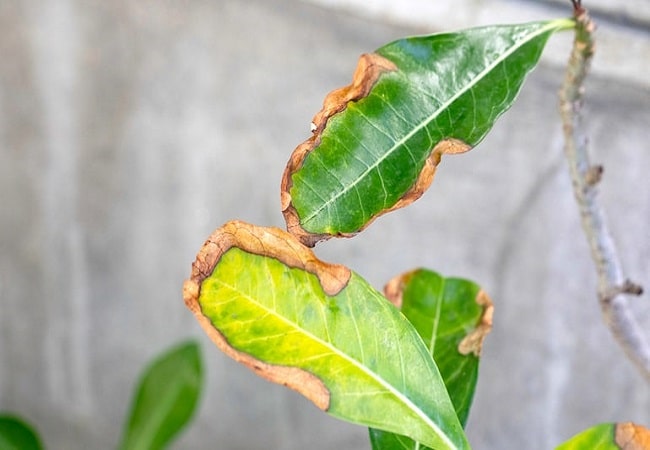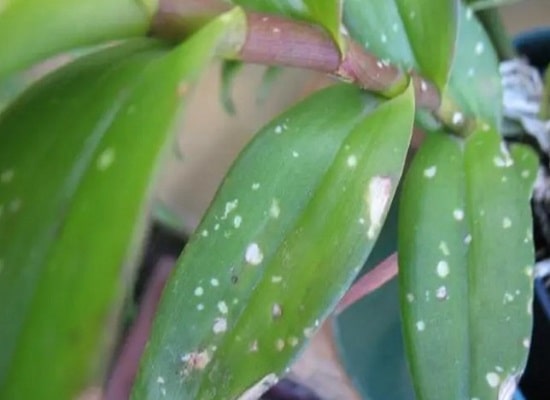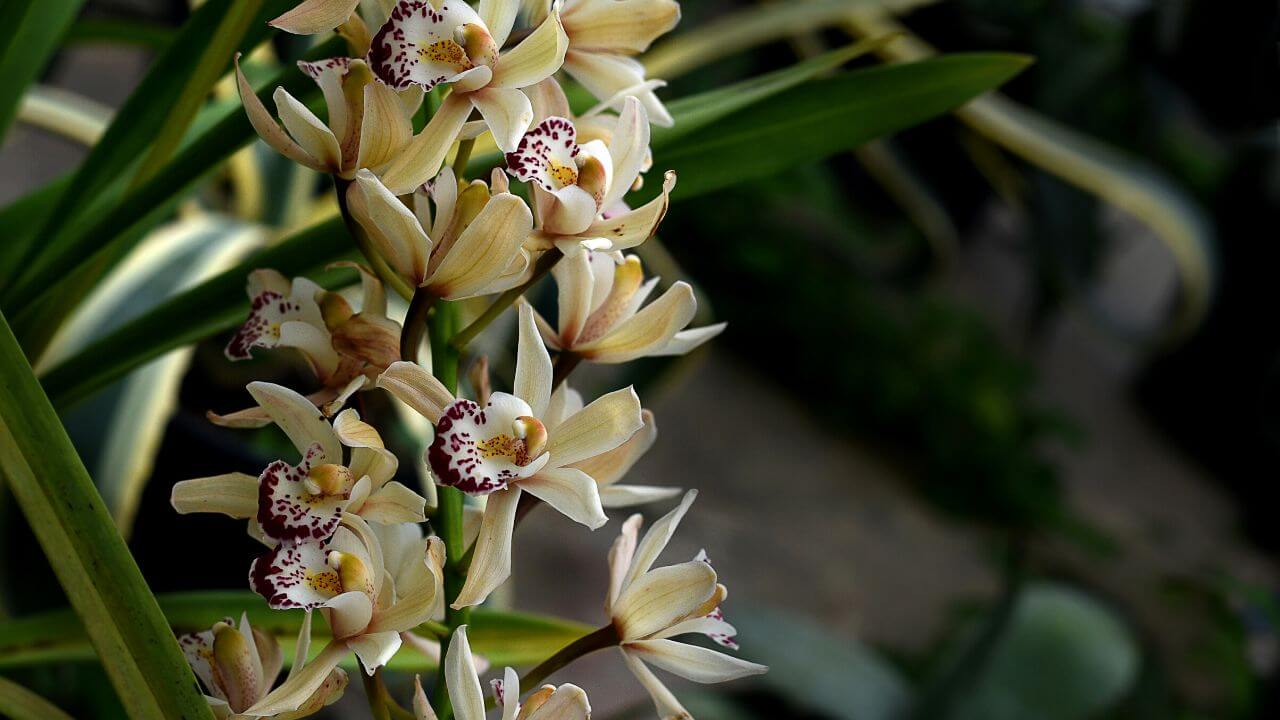Cymbidium orchids are popular houseplants because they have pretty flowers and thick, healthy leaves. But sometimes, white spots show up on the leaves of Cymbidium orchids.
Most likely, white spots on orchid leaves are caused by a Phytophthora species, a fungus. These spots are easy to find because they are white, feel like velvet, and have yellow rings around them. Fungi can also cause minor defects or bumps on the surface of a leaf.
If you want to know why this is happening, you’re lucky. This blog post will explain why Cymbidium orchid leaves have white spots and what you can do to prevent or treat them. Keep reading to find out more!
Quick Navigation
Causes And Solution Of White Spots On Cymbidium Orchid Leaves

Cymbidium orchids are beautiful, exotic plants that can add a lot to any home or garden. Many diseases and pests can hurt these plants and cause white spots on the leaves. Five potential causes and solutions are given in below:
Inappropriate Watering
Several things could cause white spots on the leaves of Cymbidium orchids. One possibility is that the way the plant is watered is unsuitable. Here are a few things you should think about:
- Overwatering: If the plant gets too much water, white spots may appear on the leaves. Before you water the plant, check how wet the soil is, and only water it when it is dry.
- Water Quality: The leaves may get white spots if you use mineral-rich water to water your Cymbidium orchid. Try using water that has been cleaned or distilled instead.
- Water Temperature: Too cold or hot water might stress the plant and cause white patches on its leaves. Water your Cymbidium orchid with room-temperature water.
- Watering Can: When you water a plant with a watering can that has a narrow spout, it is hard to get the water to go everywhere. This can cause dry spots on the leaves, which may look like white spots. Try spreading the water with a watering can that has a broader spout.
Insufficient Humidity
Insufficient humidity may create Cymbidium orchid leaf white spots. Cymbidium orchids like 50-70% relative humidity. Low humidity may stress the plant, causing white patches on the leaves.
You can make the air around your Cymbidium orchid more humid in a few ways:
- Use A Humidifier: A humidifier can help to increase the moisture in the room where your Cymbidium orchid is located. Make sure to keep the humidifier clean to prevent the growth of bacteria or fungi.
- Group Plants Together: Placing your Cymbidium orchid near other plants can help to increase the humidity around it. The plants will transpire, releasing moisture into the air.
- Use A Pebble Tray: Fill a tray with pebbles and add water. Place the pot of your Cymbidium orchid on top of the pebbles, ensuring the pot is not sitting in the water. As the water evaporates, it will increase the humidity around the plant.
- Mist The Leaves: Mist the leaves of your Cymbidium orchid with a spray bottle filled with water. Be careful to keep the leaves manageable, as this can lead to other issues.
Powdery Mildew Causes White Spots On Leaves
Fungus-caused powdery mildew may create white patches on Cymbidium orchid leaves. White or gray powder on leaves indicates powdery mildew. Fungi consume plant tissue, changing leaf shape and color. Plants may die from severe fungus.
A few things can make it more likely that powdery mildew will show up on Cymbidium orchids:
- Poor Air Circulation: If the air around the plant is stagnant, it can create an ideal environment for the fungus to thrive.
- Overwatering: Overwatering the plant can cause the soil to remain too moist, which can develop fungal diseases like powdery mildew.
- High Humidity: High humidity can create an ideal environment for the fungus to grow.
To prevent powdery mildew on your Cymbidium orchid, ensure the plant has good air circulation, avoid overwatering, and maintain a moderate humidity level. If the plant develops powdery mildew, you can treat it with a fungicide or a mixture of water and hydrogen peroxide. To prevent fungal spread, remove diseased leaves.
The Leaves Have Frostbite Or Scorch

Frostbite and scorch are two types of damage that can affect the leaves of a Cymbidium orchid.
Frostbite occurs when the temperature drops too low for the plant to tolerate, causing the cells in the leaves to freeze and die. Brown or black spots on the leaves usually characterize frostbite. To prevent frostbite, protect your Cymbidium orchid from extreme cold by bringing it indoors or providing it with a frost cover.
On the other hand, scorch is caused by excessive heat and sunlight. The leaves of the plant may become yellow or brown and develop dry, crisp edges. To prevent scorch, ensure to provide your Cymbidium orchid with sufficient shade and avoid placing it in direct sunlight for extended periods.
Suppose you suspect your Cymbidium orchid has frostbite or scorch. In that case, it is essential to protect the plant from further damage and provide it with the proper care and conditions. This may include adjusting the temperature or light levels and providing the plant with sufficient water and nutrients.
Infestation Of Mealybugs
Mealybugs can make white spots on the leaves of Cymbidium orchids. Mealybugs are minor, white, fuzzy bugs that feed on plant sap. They gather under leaves and at the joints of plants. If left unchecked, mealybugs that drink the juice from leaves could cause the plant to turn yellow, wilt, and die.
To control mealybug infestations on your Cymbidium orchid, you can try the following steps:
- To remove the mealybugs by hand, use a cotton swab or a toothbrush.
- Spray the plant with water, dish soap, or horticultural oil.
- Use a biological control, such as ladybugs or lacewings, which feed on mealybugs.
- Use a chemical insecticide according to the instructions on the label.
Always follow treatment recommendations to avoid harming people, pets, and other plants. Isolating the affected plant may help prevent mealybug spread.
Prevention & Treatment For White Spots On Cymbidium Orchid Leaves

Various factors, including fungal or bacterial infections, nutrient deficiencies, and environmental stress, can cause white spots on the leaves of a Cymbidium orchid. To prevent and treat white spots on the leaves of a Cymbidium orchid, follow these tips:
- Keep The Orchid’s Environment Clean: Remove dead or diseased leaves and flowers regularly, and avoid overwatering to prevent fungal infections.
- Provide Proper Nutrition: Ensure the orchid gets the right nutrients by using a well-balanced fertilizer and ensuring that the soil is not too alkaline or too acidic.
- Control Pests: If the white spots are caused by pests, such as aphids or mealybugs, use a natural pest control solution or an insecticide formulated explicitly for orchids.
- Improve Air Circulation: Increase air circulation around the orchid by placing it in a well-ventilated area or using a fan. This can help prevent fungal infections and other problems caused by stagnant air.
- Use A Fungicide: If a fungal infection causes the white spots, use a fungicide designed explicitly for orchids to treat the problem. You must follow the product label instructions carefully.
- Consult A Professional: If you cannot identify the cause of the white spots or resolve the issue, consider consulting an experienced orchid grower or a plant pathologist for further advice.
Signs Of Improvement
There are a few signs that your Cymbidium orchid is improving after experiencing white spots on its leaves:
- New Growth: If your Cymbidium orchid produces fresh, healthy leaves, it is a good sign that the plant is improving.
- Increased Vigor: If the plant appears more lively and energetic, with increased flowering and growth, it is likely to recover from any issues it may have had.
- The White Spots Start To Shrink In Size: As the white spots begin to heal, they may appear smaller and less noticeable.
- Reduced Or Eliminated White Spots:If the white spots on the leaves are decreasing in size or disappearing altogether, it is a good indication that the plant is improving.
- The Orchid Starts To Grow New, Healthy Leaves: If a pest infestation or disease causes the white spots, the orchid might start to grow new, healthy leaves once the issue has been resolved.
- The Orchid’s Overall Health Improves: As the orchid starts to recover from the white spots, you may notice that its overall health improves. This could include increased growth, flowers, and a more vibrant appearance.
It’s essential to the patient and gives your orchid time to recover. Suppose the white spots do not improve or continue to spread despite your efforts to address the issue. In that case, consulting a local nursery or professional horticulturist may be helpful for further assistance.
Common Mistakes To Avoid
When taking care of a Cymbidium orchid, here are some common mistakes to avoid:
- Overwatering: One of the most common mistakes when caring for a Cymbidium orchid is overwatering. It is essential to check the soil moisture level before watering and only water the plant when the soil is dry to the touch. Overwatering can lead to various issues, including root rot and fungal infections.
- Using The Wrong Potting Mix: Cymbidium orchids like soil that drains well and has a lot of organic matter. If you use a terrible potting mix, your plants may not drain well and have other problems.
- Placing The Plant In Direct Sunlight: Cymbidium orchids do not tolerate direct sunlight well and can become scorched if exposed for extended periods. Make sure to provide the plant with sufficient shade and indirect light.
- Allowing The Plant To Dry Out: Cymbidium orchids prefer to be consistently moist but not soggy. Allowing the plant to dry out can lead to wilting and other issues.
- Using Tap Water: Tap water can contain minerals and chemicals that can harm your Cymbidium orchid. It is best to use purified or distilled water to water the plant.
Avoid these blunders and give your Cymbidium orchid the proper care and environment to help it develop.
Most Commonly Asked Questions
Can I Spray Water On Orchid Leaves?
Yes, you can usually spray water on the leaves of an orchid without hurting it. Misting orchids regularly can help raise the humidity around the plant and help it thrive. But it’s essential to pay attention to your orchid needs since different orchids may have different watering and humidity needs.
When you water or mist your orchid, ensure you use water at room temperature and don’t get the leaves too wet, which can cause rot and other problems. It’s also a good idea to wait until the leaves are dehydrated before misting them again. This can help keep the leaves from getting too wet.
How Do You Tell If Your Orchid Has A Virus?
There are a few different signs that an orchid may be infected with a virus:
- Mottled Or Distorted Leaves: When an orchid has a virus, its leaves often look mottled or like a mosaic. The leaves may also look like they are warped or twisted.
- Stunted Growth: Virus-infected orchids may experience stunted growth, with smaller leaves and flowers than usual.
- Yellowing Of The Leaves: Some virus-infected orchids may exhibit yellowing of the leaves, which can signify chlorosis.
- Necrosis: Necrosis, or the death of plant tissue, is another sign that an orchid may be infected with a virus. Necrosis may appear as black or brown areas on the leaves or flowers.
What Is A Natural Fungicide For Orchids
Several natural options you can use as fungicides for orchids:
- Baking Soda: Mix 1 teaspoon of baking soda and 1 quart of water, and spray the affected areas of the orchid.
- Neem Oil: Neem oil is a natural pesticide and fungicide used to treat orchids. Mix a solution of 1 teaspoon of neem oil and 1 quart of water, and use it to spray the affected areas of the orchid.
- Garlic: Crush a few garlic cloves and mix them with a quart of water. Let the mixture sit for a few hours, then strain out the solids and use the liquid to spray the affected areas of the orchid.
- Tea Tree Oil: Tea tree oil is another natural oil that works well to keep orchids from getting fungal infections. It is also thought to kill bacteria, which makes it helpful in treating a wide range of plant diseases.
Can You Spray Hydrogen Peroxide On Orchids?
Hydrogen peroxide (H2O2) disinfects orchids naturally but use it carefully. Hydrogen peroxide may destroy orchid leaves and blooms if used too often.
Use 3% hydrogen peroxide and water in a spray bottle to clean orchids. Avoid wetting the plant by lightly misting the fluid. The solution is best used on healthy plants to avoid diseases and pests.
Hydrogen peroxide may bleach or discolor certain flowers and foliage, so test it on a tiny, inconspicuous section of the plant.
Can You Spray Vinegar On Orchids
Carefully clean orchids with vinegar. Vinegar may damage orchid leaves and blooms if used too much or too frequently.
Use white vinegar in a spray bottle on orchids. How much vinegar to put in water depends on the orchid’s sensitivity and the vinegar’s strength. One part vinegar to three parts water is a good starting point, but your plant and condition may need a different ratio.
Mist flowers and foliage with the solution. Don’t drown the plant. The solution is best used to prevent diseases and pests in healthy plants.
Final Word
Poor watering, low humidity, fungal infections, and frostbite, scorch, and mealybug infestations may create white patches on Cymbidium orchid leaves. To avoid and cure white spots on the leaves, you must take care of the plant and solve any difficulties.
Adjusting irrigation, humidity, fungal diseases, mealybug infestations, and excessive temps may help. Following these methods and caring for your Cymbidium orchid may help it flourish and recover.

I’m Md. Mahfuz Anam always enjoys taking care of plants and gardening. I find it therapeutic and a great way to relax. I have also always been interested in learning about different types of plants and how to care for them.


